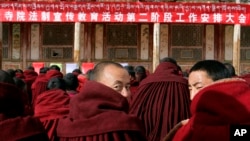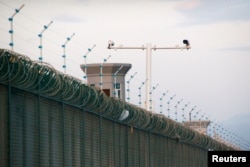At the Sog County “reform through re-education center” in Nagchu Prefecture of the Tibetan Autonomous Region, “Those who the officials didn’t like would be captured and tortured with electronic devices. When they become unconscious, [the torturers] would splash water on their faces until their victims regained their consciousness. After doing that for a long time, they would use a black rubber tube as well as electronic baton to torture people. The bruised bodies of the prisoners turned blue and black, and people become half-dead. For some [strange] reason, their bones were not broken.”
This description of daily life comes from a two-part journal written by a former inmate of one of the camps that was obtained by the Tibetan Service of the Voice of America, and some organizations of exiled Tibetans. The author, believed to be a Tibetan monk, was put in the re-education camp in July 2017 after studying at an unnamed Tibetan Buddhist institute in Qinghai Province, on the Tibetan Plateau in northwest China.
Tibet, then Xinjiang
Cultural anthropologist, historian and University of Colorado professor, Carole McGranahan, the author of “Arrested History: Tibet, the CIA and Memories of a Forgotten War,” reviewed the journal and found it an “authentic recounting of what it is like to be a prisoner in a re-education camp in Tibet.”
“The details given correspond to our understanding of what such re-education centers look like, and these re-education camps, detention camps, internment camps are found not only in Tibet but right now, [in] 2019, there are also many in which Uighurs — Uighur Muslims — are prisoners in Xinjiang as well. So we are seeing this in both Tibet and Xinjiang,” she told VOA.
The Tibetan journal recounts brutal practices that continued into 2017, but by that time, Chen Quanguo the camp’s top administrator, had moved on, appointed by Beijing as party secretary of the Xinjiang Autonomous Region in 2016.
Since then, under his administration, hundreds of thousands of Uighur Muslims have been imprisoned in similar re-education centers as security and surveillance in the region has been tightened using methods Chen employed in Tibet, such as setting up security stations in every intersection in the cities and passport confiscation, according to the South China Morning Post.
“Tibet is the precursor to what is happening,” McGranahan said. “The Chinese architect of the Uighur ‘re-education’ or concentration camps is Chen Quanguo. Where was he before Xinjiang? In Tibet from 2011-2016, in charge of surveilling, policing and oppressing Tibetans.
“Global Islamophobia is enabling current Chinese Communist abuse in Xinjiang, but we need to connect what is happening in Xinjiang with what has happened in Tibet since the 1950s,” McGranahan continued. “The logics, structures, and tactics of oppression are similar, and similarly devastating.”
Human rights activists have called for the imposition of international sanctions on Chen, according to Human Rights Watch.
Calls to the Chinese Embassy in Washington asking for comment went directly to a voicemail system that hung up before messages could be left.
Pema Gyal, a Tibet researcher at Tibetan Center for Human Rights and Democracy, says the journal makes it possible to compare treatment at the re-education camps for Tibetans with what is known of the Xinjiang camps for Uighurs.
“This diary shows there are many similarities between the re-education centers in Tibet and Xinjiang,” Pema Gyal says. “This shows the way political re-education campaigns about minorities carried are exactly the same [in those two regions]. Like in Xinjiang where young women are reportedly raped, the monk’s journal [entries show] many nuns were raped in the Tibetan re-education centers.”
Camp saga begins
The journal’s saga begins with the author being accused of breaking the law by studying in Qinghai [Province] and forced to leave the Tibetan Buddhist study center on July 1, 2017. “My parents and siblings were warned that if I did not return voluntarily, they would face imprisonment, their children would be barred from attending schools, and the family would not be allowed to collect yartsa gunbu, or caterpillar fungus. Under such circumstance, I had no choice but to come back.”
According to traditional Chinese medicine, the fungus enhances male virility and is the primary income for Tibetan families in many parts of Tibet. The yartsa gunbu from Sog is prized.
“Before I was taken in, a Tibetan man from the National Security Office told me, ‘You are going to a school, not to a prison,’” the journal writer recorded.
He was allowed only his clothes and toiletries.
“As I entered [the re-education center] some women in military uniform came down. When they saw the National Security officer, they all sat. When the man spoke to them, they said in unison, ‘Yes sir, yes sir.’ I thought that was rather strange.”
Everyone in military uniforms
He soon learned that the woman in the military uniform were detained Tibetan nuns. While being forced to stand still near a wall before he was to taken to the prison authority’s office to register, he saw from the corner of his eyes more men and women in military uniforms.
“They also looked at me from the corners of their eyes.”
After three motionless hours, he was taken to the prison director’s office.
“He scolded me. ‘Stupid,’ he yelled. ‘Where did you go and what did you study,’ he asked. I told him the name of the place in Qinghai where I studied and what I studied. He asked me many other questions, including whether I saw His Holiness the Dalai Lama’s photos or [listened to his] audios and if I had brought back any of them with me. I replied to his questions. He was very angry, punched on his desk and cursed me.”
The monk had to pay 150 yuan for a military uniform he was required to wear, then was taken to a prison cell already housing six inmates. One of them was the cell leader who wrote down the monk’s name and asked him some procedural questions.
“‘Do you trust the Communist Party?’” he asked me. “I didn’t give an answer right away. I saw from the corner of my eyes that the others [in the cell] were signaling me to answer. Then I said, ‘Yes.’”
‘Fire of anger burned inside’
The monk was then given three days to learn the Chinese national anthem and two other Chinese songs, including a song, the “Sun and Moon Are Brothers Who Share the Same Mother” made famous by the Tibetan soprano Tseten Dolma during China’s Cultural Revolution.
Failure meant facing “severe consequences,” he wrote.
“After a few days, I realized that the lives in this place was far from that of a school. This was not a school at all. Aside from a few laypeople, the majority of them (inmates) were monks and nuns who had studied in Qinghai.”
The food in was barely edible … “It smelled dusty and contains dust, dead bugs, and pieces of rocks.”
If one person disobeyed authorities or tried to help elderly inmates who collapsed from exhaustion or were injured by torture, authorities punished all the inmates by cutting rations.
“So, even though the fire of anger burned inside, no one would let the smoke come out their mouth,” he wrote, using a traditional Tibetan aphorism. “This eventually caused many people developing heart diseases.”
The daily political indoctrination classes were “designed to mainly denounce us, and to denounce His Holiness the Dalai Lama. It taught us some random legal education, too, but nothing useful. They sometimes acted as children. A big nation denouncing an old lama living so far away was both sad and laughable.”
Nuns tortured, raped
The journal writer described the torture of nuns who “became unconscious. The prison guards would compete among themselves to get them first and take them away. Who knows what they did to them. I heard that some young officers were seen pressing nuns under them in their bedrooms.” The Tibet Center for Human Rights and Democracy has called this rape.
Chinese authorities released the journal keeper after almost four months of detention. But his freedom of movement remained restricted, at least during the time he wrote his journal.
“After we were released, some of us have to go to local police station every day to register. Some people have to go every three days and some once a week. When we go to police station, we are ordered to clean their offices, outside building, wash their clothes and dishes. We are not allowed to go to the monastery to live, neither are we allowed to visit other families to perform rites for them. We are banned from traveling to other counties, other prefectures or other cities. Our IDs are kept at the National Security Office.”













